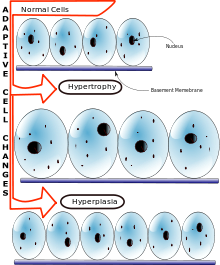Gill hyperplasia is a medical condition consisting of the inflammation, hyperplasia, or hypertrophy of gill tissue, caused by disease, poor water quality, or injury of the gills. Gill function is often impaired, causing significant oxidative stress. Anabantiformes endure hyperplasia better than other species due to the possession of a labyrinth organ. Gill hyperplasia is frequently accompanied with symptoms including lethargy, lack of appetite, and floating near inlets. Secondary bacterial infections and septicemia may occur as a result of deterioration in respiratory function.
Causes
Chronic irritation of the gills is the primary cause of gill hyperplasia. Continuous ammonia nitrogen exposure has been found to lead to a substantial increase in cases, as well as exposure to heavy metals, and injury to the gills. Some parasitic, protozoan, and bacterial species may also cause gill hyperplasia.

Infections known to cause gill hyperplasia listed below
- Chilodonella
- Trichodina
- Amyloodinium
- Ichthyobodo necator (formerly known as Costia necatrix)
- Ichthyophthirius multifiliis
- Gill flukes
Treatment
Treatment of severe cases is difficult, and often unreliable, though a mild to moderate case may be cured. The first and most essential step to the treatment of gill hyperplasia is to deal with the underlying cause (some of which listed above). Additional oxygen and aquarium salt may also help with recovery.
References
- ^ Zhong, Liang; Liu, Sha; Zuo, FengYuan; Geng, Yi; Ouyang, Ping; Chen, Defang; Yang, Shiyong; Zheng, Wei; Xiong, Yinlin; Cai, Wenlong; Huang, Xiaoli (2023-04-01). "The IL17 signaling pathway: A potential signaling pathway mediating gill hyperplasia and inflammation under ammonia nitrogen stress was identified by multi-omics analysis". Science of the Total Environment. 867: 161581. Bibcode:2023ScTEn.86761581Z. doi:10.1016/j.scitotenv.2023.161581. ISSN 0048-9697. PMID 36638999. S2CID 255801441.
- "Gill Disease: A Distressing Situation – Koi & Aquarium Fish Diseases". January 2020. Retrieved 2023-07-06.
- "Gill Hyperplasia - WikiVet English". en.wikivet.net. Retrieved 2023-07-07.
- Temmink, J. H. M.; Bouwmeister, P. J.; De Jong, P.; van den Berg, J. H. J. (1983-09-01). "An ultrastructural study of chromate-induced hyperplasia in the gill of rainbow trout (Salmo gairdneri)". Aquatic Toxicology. 4 (2): 165–179. Bibcode:1983AqTox...4..165T. doi:10.1016/0166-445X(83)90053-X. ISSN 0166-445X.
- Muhvich, Ann G; Jones, Raymond T; Kane, Andrew S; Anderson, Robert S; Reimscheussel, Renate (1995-05-01). "Effects of chronic copper exposure on the macrophage chemiluminescent response and gill histology in goldfish (Carassius auratusL.)". Fish & Shellfish Immunology. 5 (4): 251–264. Bibcode:1995FSI.....5..251M. doi:10.1006/fsim.1995.0025. ISSN 1050-4648.
- "Gill Hyperplasia - WikiVet English". en.wikivet.net. Retrieved 2023-07-06.
- Mansell, B; Powell, M D; Ernst, I; Nowak, B F (May 2005). "Effects of the gill monogenean Zeuxapta seriolae (Meserve, 1938) and treatment with hydrogen peroxide on pathophysiology of kingfish, Seriola lalandi Valenciennes, 1833". Journal of Fish Diseases. 28 (5): 253–262. Bibcode:2005JFDis..28..253M. doi:10.1111/j.1365-2761.2005.00625.x. ISSN 0140-7775. PMID 15892750.